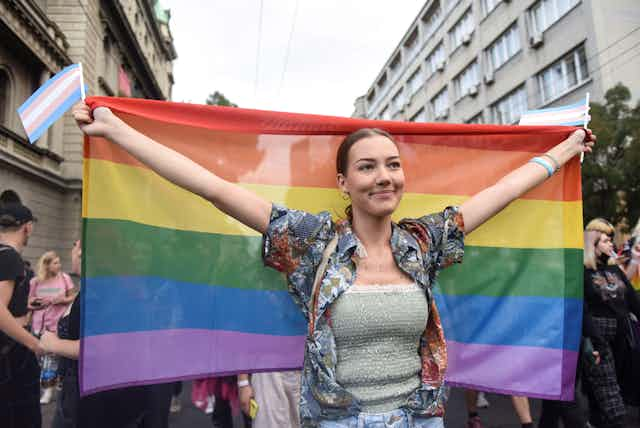Four days before the streets of Belgrade were to host EuroPride 2022, LGBTQ+ activists were handed a letter from Serbia’s interior ministry informing them that the proposed route for the Pride march had been rejected and telling them to submit a revised route. The catch? The request needed to have been handed to the police the previous day to be considered. So it amounted to an effective ban.
Serbian LGBTQ+ activists have told me that despite this they will march along the original route as planned. In more ways than one, it feels like history is repeating itself.
In 2019, Belgrade was elected by the European Pride Organisers Association members to host EuroPride, a pan-European Pride event which is held annually in a different European city. This was a major first for EuroPride: the first time the event would be held outside the European Economic Area (EEA) and a major recognition of how Belgrade Pride has overcome a history of violence and bans to become a regular and safe event each year since 2014.
The decision to effectively ban the march has echoes of 2009, when Belgrade Pride was first banned. Then – as now – the interior ministry informed activists that they would not be allowed to march through central Belgrade, but that they could use a route through Ušće park on the outskirts of the city.
The march was allowed the following year but was met by riots and extreme violence from homophobic protesters, with more than 100 people injured. The violence was subsequently used as an excuse to ban the event between 2011 and 2013.
Political tension between Kosovo and Serbia was also used as an excuse. But following the signing of the Brussels agreement between the two countries in 2013, the EU put pressure on Serbia over LGBTQ+ issues, warning the ban could affect the country’s candidacy for membership and the Belgrade Pride resumed in 2014.
The ban as a delicate political game
But this year the Serbian president, Aleksandar Vučić, called for the event to be cancelled, again blaming tensions with Kosovo as well as food and energy shortages as reasons. Vučić insists he is not homophobic, citing his choice of openly gay Ana Brnabić as prime minister and a gay family member as proof of his bona fides:
If I thought Ana Brnabić was evil, she wouldn’t be where she is. I have a woman in my extended family who is gay and I would never trade her for anything else, I don’t think there is any evil. Many of my co-workers are gay and they help me so much I can’t tell you.

Vučić also blamed anti-Pride marches over the past few weeks for his decision, saying that: “It’s not the question of whether they [extremists] are stronger, but you just can’t do it all at the same moment, and that’s it. I am not happy about it, but we can’t manage.”
What happens now?
EuroPride’s organisers said they would “use all available legal means to overturn this decision”, insisting that no matter what the outcome activists would gather on Saturday in front of the parliament building. This will effectively present the Serbian police with the thorny question of “when does a gathering become a march?” And there can be little doubt that any LGBTQ+ gathering will be met with counter protests and the threat of violence.
The intense levels of public homophobia in Serbia and the decision to effectively ban this year’s march are a setback for LGBTQ+ activists who have worked hard to establish Pride as an annual event in Belgrade since it was reinstated in 2014.
As I discussed in depth in my book: Coming in: Sexual politics and EU accession in Serbia, this fight has come at a cost, where activists felt that they had to essentially put pro-LGBTQ+ political reforms to one side, as the battle of simply being able to openly declare their sexual identity at a Pride event took all their effort.

For the government, meanwhile, the issue of LGBTQ+ rights means more in terms of Serbia’s candidacy for membership of the EU – a form of “pinkwashing” to present the country as tolerant and fully accepting of minorities without fundamentally improving their rights. But critics say that, while having an openly gay prime minister gives the appearance that Serbia is becoming more open and tolerant, Brnabić herself has said she doesn’t want to be “branded Serbia’s gay PM” and has said she wants to prioritise other policy reforms over equal rights for LGBTQ+ people.
There is also little evidence that anti-discrimination legislation – adopted in 2009 as part of the EU visa liberalisation process – are taken seriously. Implementation of the law remains minimal with very few legal cases and LGBTQ+ people still reluctant to report. Additionally, little is being done to improve court practices regarding anti-discrimination cases or to improve treatment of LGBTQ+ victims by police officers.
Since the annual Pride march was restored in 2014, activists have worked hard to put LGBTQ+ rights and politics front and centre. Now the ban has undermined this. And if there’s violence on when activists meet to defy the ban, it hands political opponents an excuse to ban it again next year, if politically convenient.

